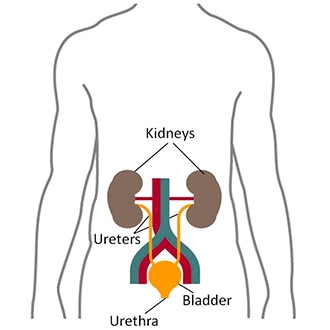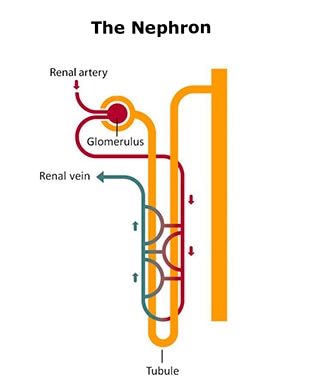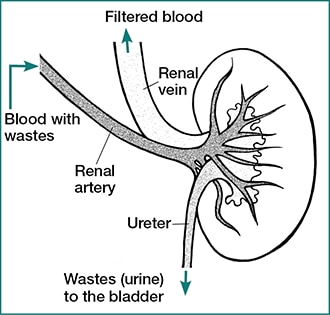Before The Kidneys Filter It Out, Where Does Urea Exist?
On this page:
- Why are the kidneys important?
- How do my kidneys work?
- How does blood menses through my kidneys?
- Clinical Trials
The kidneys are two bean-shaped organs, each about the size of a fist. They are located just below the rib cage, one on each side of your spine.
Healthy kidneys filter about a half loving cup of blood every minute, removing wastes and actress water to make urine. The urine flows from the kidneys to the bladder through two sparse tubes of muscle called ureters, one on each side of your bladder. Your bladder stores urine. Your kidneys, ureters, and bladder are office of your urinary tract.

Why are the kidneys important?
Your kidneys remove wastes and extra fluid from your body. Your kidneys also remove acid that is produced by the cells of your body and maintain a healthy balance of h2o, salts, and minerals—such as sodium, calcium, phosphorus, and potassium—in your claret.
Without this balance, fretfulness, muscles, and other tissues in your body may not work normally.
Your kidneys also make hormones that assist
- command your claret pressure level
- make red blood cells
- go along your bones strong and healthy
Sentry a video about what the kidneys exercise.
How do my kidneys work?
Each of your kidneys is made upwardly of about a million filtering units called nephrons. Each nephron includes a filter, chosen the glomerulus, and a tubule. The nephrons work through a ii-footstep process: the glomerulus filters your blood, and the tubule returns needed substances to your blood and removes wastes.

The glomerulus filters your claret
As claret flows into each nephron, it enters a cluster of tiny blood vessels—the glomerulus. The thin walls of the glomerulus let smaller molecules, wastes, and fluid—generally water—to pass into the tubule. Larger molecules, such as proteins and blood cells, stay in the claret vessel.
The tubule returns needed substances to your blood and removes wastes
A blood vessel runs alongside the tubule. As the filtered fluid moves along the tubule, the blood vessel reabsorbs almost all of the water, forth with minerals and nutrients your body needs. The tubule helps remove backlog acid from the claret. The remaining fluid and wastes in the tubule become urine.
How does blood flow through my kidneys?
Blood flows into your kidney through the renal artery. This large blood vessel branches into smaller and smaller blood vessels until the blood reaches the nephrons. In the nephron, your blood is filtered past the tiny claret vessels of the glomeruli then flows out of your kidney through the renal vein.
Your blood circulates through your kidneys many times a day. In a unmarried day, your kidneys filter about 150 quarts of claret. Most of the water and other substances that filter through your glomeruli are returned to your claret past the tubules. Simply 1 to 2 quarts go urine.

Clinical Trials
The National Constitute of Diabetes and Digestive and Kidney Diseases (NIDDK) and other components of the National Institutes of Wellness (NIH) conduct and support research into many diseases and conditions.
What are clinical trials, and are they right for you?
Clinical trials are part of clinical research and at the heart of all medical advances. Clinical trials look at new ways to forbid, detect, or treat illness. Researchers also use clinical trials to look at other aspects of care, such as improving the quality of life for people with chronic illnesses. Find out if clinical trials are right for you.
What clinical trials are open up?
Clinical trials that are currently open and are recruiting can exist viewed at www.ClinicalTrials.gov.
Before The Kidneys Filter It Out, Where Does Urea Exist?,
Source: https://www.niddk.nih.gov/health-information/kidney-disease/kidneys-how-they-work
Posted by: baileythessalky.blogspot.com


0 Response to "Before The Kidneys Filter It Out, Where Does Urea Exist?"
Post a Comment